The First Great Council (Paμhama Saag±yana)
The Second Great Council (Dutiya Saag±yana)
The Third Great Council (Tatiya Saag±yana)
The Fourth Great Council
Tipiμaka committed to writing in 93 B.C.
Two thousand four hundred fourteen years
Sixth Great Buddhist Council held at
Yangon, under he auspices of the government of Myanmar. The Prime
Minister U.Nu played the major role in organizing this Saag±yana which
has brought out a splendid recension of the Tipiμaka, its commentaries
(Aμμhakath±) and sub-commentaries (T2ka) in Myanmar script. This noble
undertaking was concluded on the full-moon day of Vesakha (May) in 1956
marking the 2500th anniversary of the Buddha’s Great Demise.
TABLE OF SIX GREAT BUDDHIST SA©G3⁄4YANA =COUNCILS
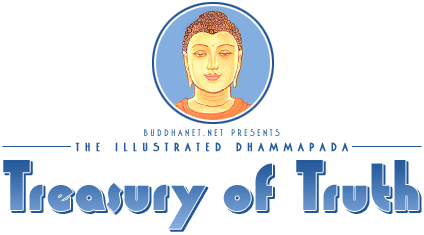
http://www.buddhanet.net/dhammapada/d_twin.htm

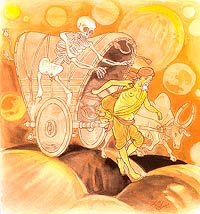 Verse 1. Suffering Follows The Evil-Doer
Explanation: All that we experience begins with thought. Our |
 |
Verse 2. Happiness Follows The Doer of Good
Explanation: All that man experiences |
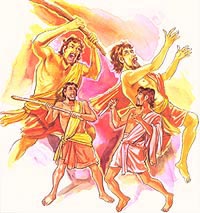 |
Verse 3. Uncontrolled Hatred Leads to Harm
Explanation: When a person holds that he was insulted, assaulted, |
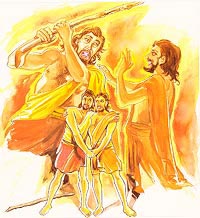 |
Verse 4. Overcoming Anger
Explanation: Living in human society, people often quarrel |
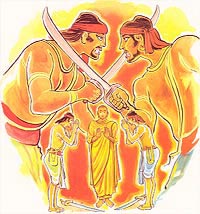 |
Verse 5. Hatred is Overcome Only by Non-hatred
Explanation: Those who attempt to conquer hatred by hatred |
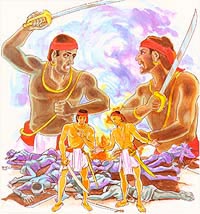 |
Verse 6. Recollection of Death Brings Peace
Explanation: Most of us are not prepared to face the reality |
 |
Verse 7. Laziness Defeats Spirituality
Explanation: Those who dwell on the attractiveness of sensual |
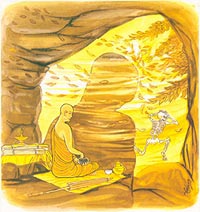 |
Verse 8. Spiritual Strength is Undefeatable
Explanation: Those who dwell on the unattractiveness of sensual |
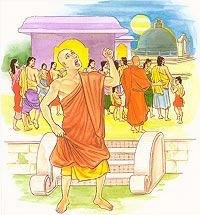 |
Verse 9. Those Who Do Not Deserve the Stained Robe
Explanation: A monk may be stained |
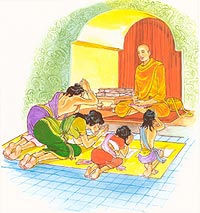 |
Verse 10. The Virtuous Deserve the Stained Robe
Explanation: Whoever dons the ’stained cloth’, being free |
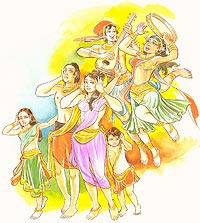 |
Verse 11. False Values Bar Spiritual Progress
Explanation: A person interested in spiritual progress must |
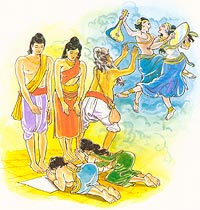 |
Verse 12. Truth Enlightens
Explanation: The wise person who is able |
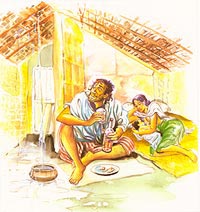 |
Verse 13. Lust Penetrates Untrained Mind
Explanation: It is quite necessary that a house should have |
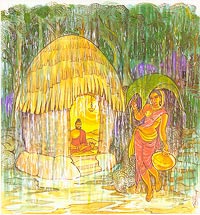 |
Verse 14. The Disciplined Mind Keeps Lust Away
Explanation: When the house is well protected by a well-thatched |
 |
Verse 15. Sorrow Springs From Evil Deeds
Explanation: People who commit evil actions are unaware of |
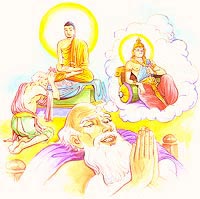 |
Verse 16. Good Deeds Bring Happiness
Explanation: A wise person does good deeds. |
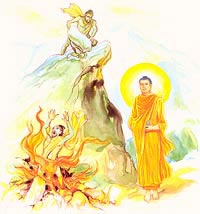 |
Verse 17. Evil Action Leads to Torment
Explanation: Those who do evil, those given to wrong doings, |
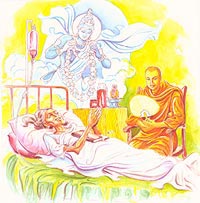 |
Verse 18. Virtuous Deeds Make One Rejoice
Explanation: The person who has done good and virtuous deeds |
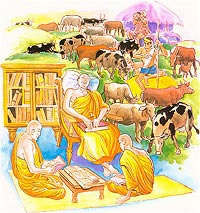 |
Verse 19. Fruits of Religious Life Through Practice
Explanation: Some persons may know the words |
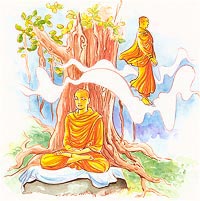 |
Verse 20. Practice Ensures Fulfilment
Explanation: A true seeker of truth through he may speak only |
| |
|
|
| |
|
|
| |
|
24
CHAPTER FOUR
The First Great Council (Paμhama Saag±yana)
Just
after the Mah±parinibb±na of the Buddha, when many bhikkhus were
profoundly sad, a situation arose which compelled the leading Mah±s±vaka
(Great Enlightened Disciple), the Venerable Mah±kassapa, and other
senior Arahats, to immediately decide upon convening a Great Council
(Dhamma Sang2ti) and recite the entire Teaching and Discipline (Dhamma
Vinaya), to preserve, in its pristine purity, the Dispensation (S±sana)
of the Supremely Enlightened Buddha.
The situation referred to
concerned a former barber, Subhadda by name, who having become a monk,
had irreverently remarked to a group of bhikkhus, saying: “Enough,
brethren, don’t grieve, don’t lament! We are well rid of the Great
Recluse (Mah± Samana). We were much troubled by the rules of discipline,
which he had laid down,
25
saying: ‘This is allowed to you, that
is not allowed to you etc.’ But now we will be able to do what we like,
and we need not do what we don’t like.” Subhadda had become a monk in
his old age when he could no longer earn. He was an unwanted burden to
his family. So to make a comfortable living he had become a fake monk.
Having
heard what Subhadda had said, the Venerable Mah±kassapa became alarmed
and thought that unless timely precautions were taken, this attitude
definitely presaged a threat, not only to the holy life but also to the
Buddha’s Dispensation (S±sana).
The story of Subhadda’s entering the
Saagha appears in the commentery thus: “Subbhadda was a barber living in
a village called 3⁄4lavi. He had his wife and two sons.
One day the
Buddha accompanied by his disciples visited the 3⁄4lavi village. At that
time Subbhadda noticed that many people devoutly followed the Buddha
and with great respect offered d±na.
26
Seeing this, Subbhadda made a plan to earn money and reputation like
others. Accordingly he had his two sons ordained as monks and collected
material things from the people in the name of the Buddha and his
monastic disciples. People gave them whatever they could with great
devotion and trust.
After collecting offerings he invited the Buddha
and his disciples to his house where many people were also invited. But
the Buddha and his disciples did not accept his offering because it was
obtained through wrong means and with selfish intention for name and
fame.
When the Buddha was asked why he did not accept his offering,
the Buddha told him that the things which he was going to offer were
collected through wrong means and violated the precept of right
livelihood (samm± ±j2va).
Since then people, even his own family members, started taunting him.
Thus, being disrespected by everybody,
27
he harboured a grudge towards the Buddha.
As
he became older, he lost the ability to carry out his trade. And people
stopped coming to him fearing that he may cause injuries while shaving
and so on. So to get rid of all these problems he became a monk in order
to live comfortably for the rest of his life.
After becoming a monk, he did not follow the Vinaya rules and did not obey his elders, even the Buddha. This is the reason.”
Story of Subhadda
When the Buddha passed away, Subbhadda said to the monks who were lamenting and crying:
“Brethren,
don’t lament, don’t cry. Now that the Great monk (Buddha) has passed
away, we will live at ease. When he was alive he used to say: ‘don’t do
this, do that.’ Now, we are freed from such disciplinary rules, so now
we can do what we like.”
Subbhadda’s statement was heard by Venerable Mah±kassapa and he thought, this attitude poses a great threat to the Buddha
28
S±sana. So immediately he had five hundred Arahats assembled and
this Holy Saagha decided to conduct the first Buddhist Council (Paμhama
Saag±yana) at R±jagaha in Sattapanni Cave. King Aj±tasattu supported the
Council and Venerable Mah±kassapa presided over it. The Council recited
for seven months the entire Tipiμaka as it is found today. The reciters
were the Venerable Up±li, who recited the Vinaya Piμaka, and the
Venerable 3⁄4nanda, who recited the Sutta and Abhidhamma piμakas. Thus
the pure teachings of the Buddha continued to be preserved till the
present generation of the Therav±da Saagha.
The Venerable Mah±kassapa
adopted the following procedure: “First he congregated the Saagha and
proposed that in order to preserve the purity of the Buddha-vacana and
for the benefit of posterity, a Council of Reciters (Dhamma Saagiti) be
immediately convened. The Saagha agreed and selected R±jagaha to be the
venue and authorized the Venerable Mah±kassapa to choose the Reciters.
He chose five hundred such Arahats
29
(Enlightened Disciples), who
were endowed with Paμisambhid± ñ±na, supernormal power of retaining in
memory and reciting at will the entire Buddhavacana. Then he informed
the King of Magadha, Aj±tassattu, of this decision. King Aj±tasattu, a
lay-follower of the Buddha, had a large, well-decorated structure built
outside the Sattapanni cave and made all other arrangements for the
Council to meet.”
Thus three months after the Buddha’s Great Demise
(Mah±parinibb±na), five hundred of the eminent Arahat Disciples of the
Buddha met at R±jagaha and recited the entire Teaching of the Buddha for
seven months. The Venerable Mah±kassapa presided over this unique
Synod, known as the First Great Council (Paμhama Dhamma Saag±yana). The
Venerable Up±li Thera, whom the Master himself had placed as the
authority on Vinaya, recited, section by section, with all historical
details, the whole of the Vinaya Piμaka. The Venerable 3⁄4nanda Thera,
who was likewise designated by the Master as the Treasurer of the
Teaching (Dhamma Bhao1ag±rika), recited the entire
30
Dhamma which included the Sutta Piμaka and the M±tik± or Abhidhamma Piμaka.
Thus,
the systematization of the Teachings, which had begun in the Master’s
own time, came to be authenticated, once for all, in the First Saag±yana
by the immediate and distinguished senior enlightened disciples of the
Buddha. This Sacred Canon has faithfully preserved and handed down the
Buddha’s Dhamma upto the present time through a long line of
teacher-to-pupil tradition.
—— ——
CHAPTER FIVE
The Second Great Council (Dutiya Saag±yana)
A
hundred years after the Parinibb±na of the Blessed One the Second Great
Council was held at Ves±li, the capital of the Vajji Republic. In this
Saag±yana the Sacred Canon was once again recited for eight months, and
its authencity re-affirmed by Seven hundred Arahats, endowed with
Paμisambhid± ñ±na, under the presidentship of the Venerable Sabbak±mi
Mah± Thera. King K±l±soka was the chief lay-supporter (d±yaka), like
Aj±tasattu of the First Council. He made all the necessary arrangements
for the meeting of this Council.
This Council was necessitated by a
dispute which arose regarding ten points of the Vinaya. Some Vajji monks
wanted to change certain rules of monastic discipline in violation of
the Vinaya, to suit their lax life. For instance, they wanted to handle
and
32
Much though he recites the sacred
texts, but acts not
accordingly, that heedless man is liike a cowherd who only counts the
cows of others - he does not partake of the blessings of the holy life.
Dhp- 19.
31
possess money, carry salt in a horn to improve the taste of
alms-food, drink fermented drinks and usher in such intemperate
practices as would destroy the very basis of the holy life in the
dispensation of the Buddha.
They formulated ten rules on their own
which if allowed, would completely nullify the spirit of voluntary
poverty and spiritual purity, the Buddha had enunciated. So the
Venerable Yasa, one of the early Elders ordained by Buddha and now 165
years of age, seeing the decline among the disputing Vajji monks,
created a public opinion against their degenerate practices.
These ten formulations were:
1. Kappati siagilona kappo.
It
is allowable to carry salt in a horn- container during the alms-round
to flavour the alms-food. This practice goes against the vinaya
p±cittiya rule No. 38 dealing with non-hoarding of food (sannidhik±raka)
which was laid down by the Buddha in S±vatthi.
33
2.
Kappati dvaagula kappo.
It
is allowable to eat after the sun had crossed two fingers breath, from
the meridian at mid-day, which becomes ‘untimely eating’
(vik±labhojana). This practice violates the vinaya p±cittiya rule No. 37
dealing with eating or partaking food at the wrong time which was laid
down by the Buddha in R±jagaha.
Kappati g±mantara kappo.
It is
allowable to eat twice in a village. This practice goes against the
vinaya p±cittiya rule No. 36 dealing with eating twice in the same
village, which was laid down by the Buddha in S±vatthi.
Kappati ±v±sa kappo.
It
is allowable to have a separate Uposatha while staying in the same
monastery (±v±sa). This practice goes against the vinaya p±cittiya rule
called dukkaμa dealing with Uposatha - that is the monastic Community
meeting to recite the P±timokkha rules, which was laid down by the
Buddha in R±jagaha.
34
3.
4.
5. Kappati anumati kappo.
It is allowable to conduct a formal act
of Saagha without the presence of all the concerned members and
expecting that the absentee monks will automatically agree. This
practice goes against the vinaya p±cittiya rule called dukkaμa dealing
with conducting the Saagha community meeting as a whole, which was laid
down by the Buddha in Champeyyaka.
6. Kappati ±cinna kappo.
It is
allowable to blindly follow the elders saying that since my teacher or
preceptor has done it, so I will also do it, without understanding the
purpose of such conduct. This practice goes against the Vinaya p±cittiya
rule dealing with unquestioned following.
7. Kappati amathita kappo.
It
is allowable to drink butter milk at wrong time. This practice goes
against the vinaya p±cittiya rule, which was laid down by the Buddha in
S±vatthi.
8. Kappati jalogi kappo.
It is allowable to drink
fermented (alcoholic) drink. This practice goes against the vinaya
p±cittiya rule dealing with drinking of intoxicating and fermented
liquor, which was laid down by the Buddha at Kosambi.
9. Kappati adasaka1⁄2 nis2dana kappo.
It
is allowable to use expensive and stylish bed coverings. This practice
goes against the vinaya p±cittiya rule connected with bed coverings etc,
which was laid down by the Buddha in S±vatthi.
10. Kappati j±tar3pa rajata kappo.
It
is allowable to handle gold, silver etc. This practice goes against the
Vinaya p±cittiya rule connected with handling of money, gold, silver
etc, which was laid down by the Buddha at R±jagaha.
With the support
of the Saagha and the King, the Venerable Yasa together with Venerable
Revata and Ajita convened this Council and settled, once for all, these
35 36
questions of discipline of the Order. The disputant monks were
expelled from the Saagha and they formed an order of their own which
they called Mah±s±aghika. There were many splits in this group, so much
so that a hundred and fifty years later in the time of Emperor Asoka, at
least eighteen sects had mushroomed. The so-called Northern Buddhism or
Mah±yana originated from one of these splinter sects.
Apart from
settling controversies regarding the rules of the Order, another
important feature of the second Saag±yana was the confirmation of the
various classifications of the Tipiμaka under various heads, such as,
the Five Nik±yas, Nine Aagas and so on.
—— ——
The Third Great Council (Tatiya Saag±yana)
Two
hundred and fifty years after the Mah± Parinibb±na of the Buddha, the
Third Great Council was held with the support of the great Buddhist
Emperor Asoka at P±taliputta (Patna). In this Saag±yana, one thousand
Arahat Theras endowed with supernormal attainments recited the entire
Tipiμaka for nine months. This Council was presided over by Asoka’s
Teacher, the Venerable Moggaliputta Tissa, and was significant in many
ways. Not only from the Buddhist point of view was it important, but
also from the view-point of the Indian civilization as a whole. For, it
was in this Council that the Saagha, in active collaboration with the
Emperor, decided to send ‘Messengers of Dhamma’ (Dhammad3tas),
throughout the then known world.
Asokan Messengers of Dhamma
The places and names of the Asokan Messengers of Dhamma, (dhammad3tas) were as follows :
38
37
1. G±ndh±ra and Kashmira, (Kashmir and its north & western
countries, including what is now Afghanistan, and some central Asian
countries), under the leadership of Arahat Majjhantika with a group of
elders.
2. Yonaka (Macedonia, Greece), (including the Greco-Bactrian states of Europe, modern Israel, Syria, Iraq
and Egypt), under Arahat Mah±rakkhita and a group of elders.
3.
Cina-Himavanta, (China and the Himalayan countries of Ladakh, Himachal,
Nepal, Tibet, Bhutan and Sikkim), under Arahat Majjhima and a group of
five elders.
4. Suvaooabh3mi, (Burma and the South East Asian
countries of Thailand, Cambodia, Laos, Malaysia, Indonesia and Vietnam),
under the Arahats Sona and Uttara and a group of elders.
5. Sri Lanka, under the Arahat Mahinda and a group of five bhikkhus.
6. Mahi1⁄2sakamaodala, (modern
39
Karnataka and the Deccan states, including Andhra), under Arahat Mahadeva and a group of bhikkhus.
7. Mah±raμμha, (modern Maharastra and Madhya Pradesh), under Arahat Mah± Dhammarakkhita and a group of bhikkhus.
8.
Vanav±si, (the southern part of India, including Karnataka, Goa and
Kerala), under the Arahat Rakkhita and a group of bhikkhus.
9.
Aparantaka, (western India, including modern Gujrat, Rajasthan, and
Pakistan), under the Arahat Yonaka (Greek) Dhammarakkhita and a group of
bhikkhus.
Apart from spreading the Teachings of the Buddha, these
great Dhamma-missionaries contributed, in a most enduring way, towards
the promotion of civilization in a vast area and among many primitive,
often hostile, races. This is indeed an exemplary service to mankind and
something unique in the history of the world.
40
The purpose of the Great council
The purpose of conducting the
Third Great Council was to remove the impurity that had crept into the
body-politic of the Buddhist community as a result of the influx of fake
monks into the Saagha. A large number of sectarian ascetics and
mendicants had falsely donned the robe of the bhikkhu to make a
comfortable living through the gain and honour, which were showered on
the bhikkhus both by the Emperor and by the people.
This ulterior
motive had debased not only their lives but also posed a danger to holy
life as such. Further they injected their pernicious heretical views
threatening to deteriorate Buddhist life and defile the noble Teachings
of the Compassionate Buddha.
In order to safeguard the purity of the
minds of the innocent votaries, it was essential to purge the Saagha of
the evil elements and to restore the Dhamma of the Buddha to its
pristine purity. Therefore, the Holy Order, under the leadership of the
Venerable Moggaliputta Tissa, got the Third
41
Great Council convened with the support of the Emperor.
It
is recorded that sixty thousand fake monks were disrobed during this
Synod. Further, in order to counteract the perverted views of the
heretics, the great Arahat Moggaliputta Tissa compiled a treatise
entitled Kath±vatthu, the Points of Controversy, with one thousand
dialogues. Five hundred heretical controversial points were exposed and
negated by five hundred genuine dhamma points culled from the Abhidhamma
Piμaka. This work was also recited together with the texts of the
Tipiμaka, and adopted as a part of the Abhidhamma Piμaka.
In keeping
with the two previous Saag±yanas, on this occasion, one thousand Arahats
recited the Tipitaka, which was classified under various heads, such
as, Nik±yas, Aagas and Dhammakhandhas. The Third Council had a splendid
success, both in preserving the original teaching of the Buddha and in
propagating it.
Of the nine great Messengers of Dhamma who went to various countries both in and out
42
of India, the Venerable Elder (Thera) Rakkhita, belonging to Yonaka
country (modern Macedonia), went to Vanav±si, and the Venerable Elder
Mah±revata went to Mahi1⁄2saka Man1ala. Both Vanav±si and Mahi1⁄2saka
Man1ala are included in present Karnataka State.
—— ——
The Fourth Great Council
Tipiμaka committed to writing in 93 B.C.
Through
the efforts of the Arahat Mahinda, one of the nine Dhammad3tas and son
of Emperor Asoka, the Buddha-S±sana became firmly rooted in the soil of
Sri Lanka. And both the bhikkhus and the kings of the successive
generations worked actively to promote the cause of Dhamma.
A hundred
and twenty-five years after Mahinda, Sri Lanka was thrown into a
turmoil of war, famine and pestilence caused by the invasions of the
Chola rulers of South India. The Saagha was forced to abandon the holy
city of Anur±dhapura and went to the forest solitude of the Kandyan
hills. Anur±dhapura had become the main centre of Buddhism with Mah±
Vih±ra as the seat of religious learning and piety.
The holy Arahats,
the hairs of the Lord, endured great hardship during the foreign
occupation, only to preserve the treasure of the Dhamma. Five hundred
Arahats gathered in a conference, in a remote rock cave called Alu Lena
(3⁄4loka Vih±ra), which was presided
44
“There are two things, O
monks, which make the Truth-based Dhamma endure for a long time, without
any distortion and without (fear of) eclipse. Which two? Proper
placement of words and their natural interpretation. Words properly
placed help also in their natural interpretation.”
A.N. 1.2.21, Adhikaraoavagga
43
over by the Venerable Rakkhita Mah±thera. These noble Elders of the
Holy Order thought that the situation prevailing in the country
definitely indicated a future spiritual decline. Therefore, they decided
to commit into writing the Sacred Canon and its commentaries which had
been brought from India by Arahat Mahinda and his companions.
Until
now the P±li Canon had been preserved in its original form by oral
tradition through a line of Arahat-teachers who handed down the Canon to
their pupils. King Vaμμhag±mini Abhaya, who was informed of this
far-reaching decision, made the necessary arrangements.
Thus, the
Fourth Great Council was held in 93 B.C. at Alu Leoa near Matale, in
which the Sacred Tipiμaka and its commentaries were recited by five
hundred Arahats and then committed to writing on ola leaves under the
direct supervision of the Chief Adigar (Recorder of the King). It is
recorded that these ola manuscripts were checked over a hundred times by
these holy Arahats, each one separately, before passing them as
45
authentic
documents of the Tipiμaka and its commentaries. This written version
has been preserved up to our time with utmost fidelity and care by
successive generations of kings and Elders of the Saagha.
—— ——
….
the Dhammas (truths) which I have taught to you after realizing them
with my super-knowledge, should be recited by all, in concert and
without dissension, in a uniform version collating meaning with meaning
and wording with wording. In this way this teaching with pure practice
will last long and endure for a long time….
D.N. 3.177, P±s±dikasutta
46
The Fifth Great Council
Two thousand four hundred fourteen years
after the Great Demise (Mah± Parinibb±na) of the Buddha, in 1871, under
the auspices of King Mindon Ming of Myanmar, the Sacred Canon and the
commentaries were recited for five months and inscribed on seven hundred
and twenty- nine marble slabs. Two thousand and four hundred
distinguished Theras of the country participated in the Council at
Mandalay. Each of these slabs is separately housed in a beautiful Pagoda
style pandal and scrupulously kept under perfect condition to this day.
This is known as the Fifth Great Council.
The Sixth Great Council
In
commemoration of the 2500th Buddha Jayanti, in May, 1954, an
International Mah± Saagha of 2500 distinguished Theras from the various
Buddhist countries – Myanmar, Thailand, Sri Lanka, Cambodia, Laos,
India, Bangaladesh and from other countries like China, Japan, Nepal,
etc., participated in the
47
Sixth Great Buddhist Council held at
Yangon, under he auspices of the government of Myanmar. The Prime
Minister U.Nu played the major role in organizing this Saag±yana which
has brought out a splendid recension of the Tipiμaka, its commentaries
(Aμμhakath±) and sub-commentaries (T2ka) in Myanmar script. This noble
undertaking was concluded on the full-moon day of Vesakha (May) in 1956
marking the 2500th anniversary of the Buddha’s Great Demise.
From the
above account it is clear that in the First Saag±yana the P±li Canon
was authoritatively collated and established to preserve the purity of
the Buddha’s original teachings; in the second, all controversies
regarding monastic discipline, as contained in the Vinaya Pitaka, were
firmly uprooted once and for all; in the third, all philosophical
interpolations and metaphysical speculations were nipped in the bud and
the purity of Buddha’s Dhamma reaffirmed; the fourth Saag±yana,
committed the Tipiμaka and the canonical literature into writing, thus
the preservation of the original teachings by
48
Therav±da was made enduring. Further, this Council laid a strong
foundation for the flourishing of P±li post-canonical literature, which
later became more and more widespread.
—— ——
Little though he
racites the sacred texts, but puts the Teaching into practice,
forshaking lust, hatred and delusion, with true wisdom and emancipated
mind, clinging to nothing of this world or any other world - he indeed
partakes of the blessings of a holy life.
Dhp- 20.
49
TABLE OF SIX GREAT BUDDHIST SA©G3⁄4YANA =COUNCILS
Date
Venue
Presided over by
No. of Participants
Supporter
Cause / Object
Duratio n
Other important events
1st
Buddhist Council
3 months after the Buddha’s Great Demise
543 –B.C
Sattapanni Cave, Mount Vebh±ra, City of Rajagaha (India)
Ven. Mah±kassapa Mah± Thera
500 Paμisambhid± ñ±na Arahats
King Aj±tasattu
(of India)
Subhadda’s irreverent utterances after the Buddha’s Great Demise
To Preserve the purity of the original teachings of Buddha
7 Months
Ven. Up±Ii recited the Vinaya Pitaka Ven. Ananda recited the Dhamma & Abhidhamma Pitakas.
2nd
Buddhist Council
100 years after the Buddha’s Great Demise
443 – B.C
V±luk±rama Monastery, City of Vesali (India)
Ven. Sabbak±mi Ven. Yasa Ven. Revata Ven. Ajita Mah±theras
700 Paμisambhid± ñ±na Arahats
King K±l±soka (of India)
Vajji Monk’s ten controversial points. Propagation of false doctrine
To preserve the purity of Vinaya rules Laid down by the Buddha
8 Months
Saagha divided into two – Theravadin & Mahasaaghika
3rd
Buddhist Council
250 years after the Buddha’s Great Demise 293 B.C
Asok±rama Monastery, City of Pataliputta (India)
Ven. Maggaliputta Tissa
Mah± Thera
1000 Paμisambhid± ñ±na Arahats
King Dhamm±soka
(of India)
Prevalence of fake monks and heretical views
To expel the fake monks and to preserve the purity of the Sangha
9 Months
- More than 60,000 fake monks were expelled.
- 9 groups of Dhammadutas were sent to various countries
4th
Buddhist Council
450 years after the Buddha’s Great Demise 93-BC
3⁄4loka Cave Aluvih±ra Matale, Malaya District, (Sri Lanka)
Ven. Rakkhita Maha Thera
500 Arahats
King Vaμμag±mani Abhaya
(of Sri Lanka)
Prevalence of materialism and moral decline due to war and a hostile king
To recite and render into writing the Tipiμaka and preserve it from external threats like war etc.
1 Year
Tipiμaka was written on ola leaves for the first time.
- The King made many copies and distributed them all over the country.
5th
Buddhist Council
2414 years after the Buddha’s Great Demise
1871-A.D
Dakkhin±r±ma Monastery, Mandalay, (Burma)
Venerable Mahatheras J±gar±bhiva1⁄2sa Narendr±bhidhaja Sumaagalas±mi
2400 Learned Mah±theras
King Mindon (of Burma)
To prepare a uniform edition of Tipitaka and write it down on marble slabs for it to endure long
5 Months
Tipiμaka was written on 729 marble slabs and enshrined in a library called (Mystery library)
6th
Buddhist Council
2500 years after the Buddha’s Great Demise
1954-56 A.D
Mahap±s±na Cave, Kab±- Aye, Yangon (Myanmar)
Ven. Revata Maha Thera
2500 Learned Mah±theras
Government of Myanmar PM – U NU President Sao Shwe Thaik
To reathenticate the Teachings and propagate the Dhamma all over the world
2 Years
The participant monks were from – Thailand, Ceylon, Laos, Cambodia, India etc.
50
Rector
JC

INSIGHT-NET- Online A1 (Awakened One) Tipiṭaka Research & Practice University in Visual Format (FOA1TRPUVF)
Online A1 (Awakened One) Tipiṭaka Research & Practice University in Visual Format (FOA1TRPUVF)
From
PRABANDHAK